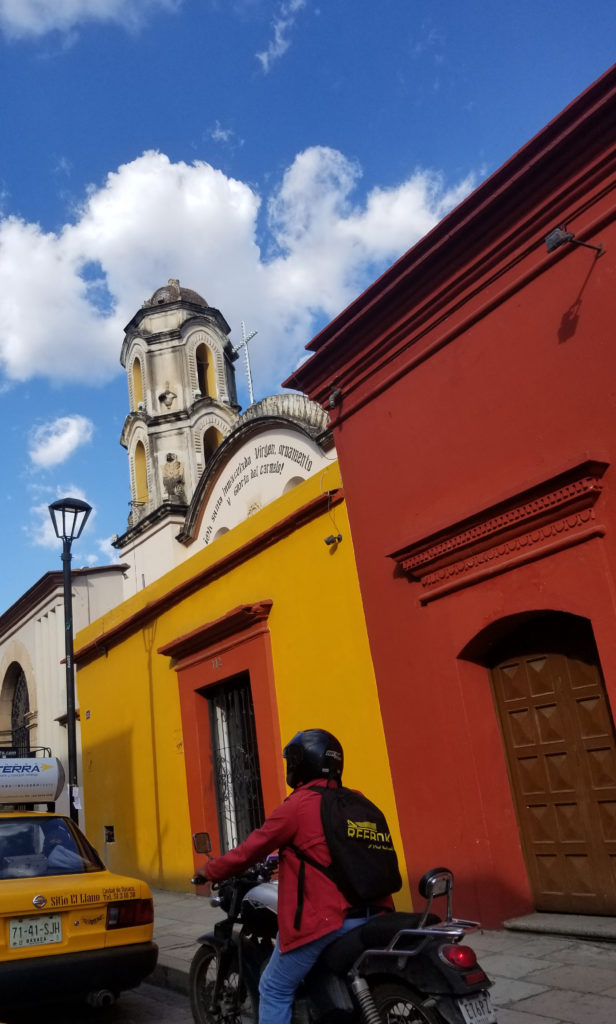
 Text and photos by Mary L. Peachin
Text and photos by Mary L. PeachinVol. 22, No. 6 , April, 2019
Culturally diverse Oaxaca City lies in a valley surrounded by the scenic mountains of Sierra Madre del Sur. Its Mexican, Zapotec and Mixtec people, scattered throughout rural villages, have established a unique cuisine, its artisans design fine handicrafts, and the people celebrate numerous ethnic celebrations. Spanish is a second language.
Oaxaca, the size of Indiana, along with the state of Chiapas, are Mexico’s most illiterate and poor. At the same time Oaxaca is one of the richest areas both culturally and archaeologically. The locals’ value on religion and family add to this wealth.
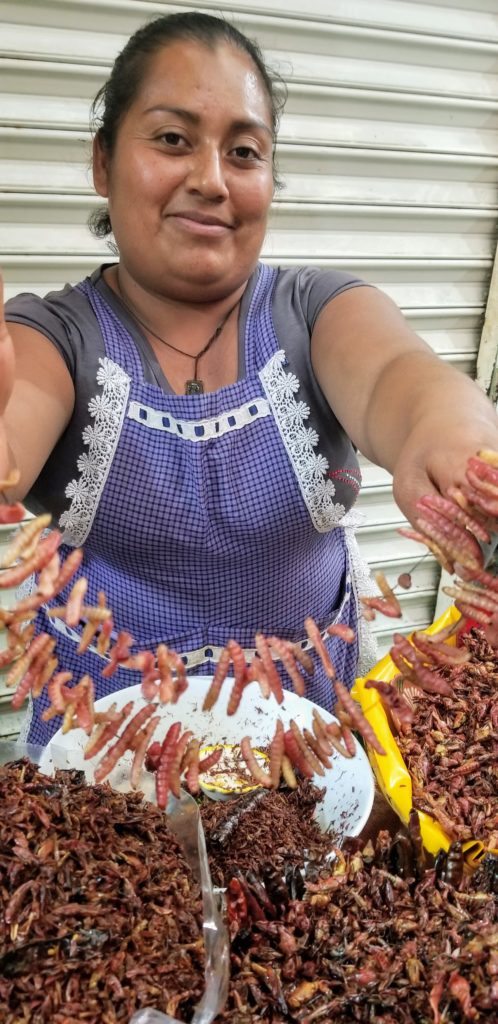
Chapulines crickets and Mescal worms or gusano de magnetAfter passing through the zocalo, the foundation of the city, its market day in suburban Tlacolula. Meat barbecued indoors makes the market smoky. Vegetables like squash, papaya, cilantro, tomatoes, to name a few, are grown organically without pesticide. More than 20,000 chickens are fed and to enrich their color they are dyed with marigolds. Chapulines or crickets are sold in numerous stalls, while chicatanas ants, more of a delicacy, are scarce. Adjacent to the market is a 16th century chapel filled with Mexican baroque artifacts.
A native of Oaxaca, Benito Hernandez, owner of Discover Oaxaca Tours, expertise was especially meaningful. An added enhancement was his knowledge of bird species. Driving along two lane roads edged by fallow fields, we saw a Northern Harrier Raptor, an orange-faced Northern Crested Caracara, called the Golden Eagle in Texas, and the rare Swallow-tailed Flycatcher. The landscape offered the occasional brilliant evergreen African yellow tulip tree, fushia bougainvillea, and white morning glory trees.
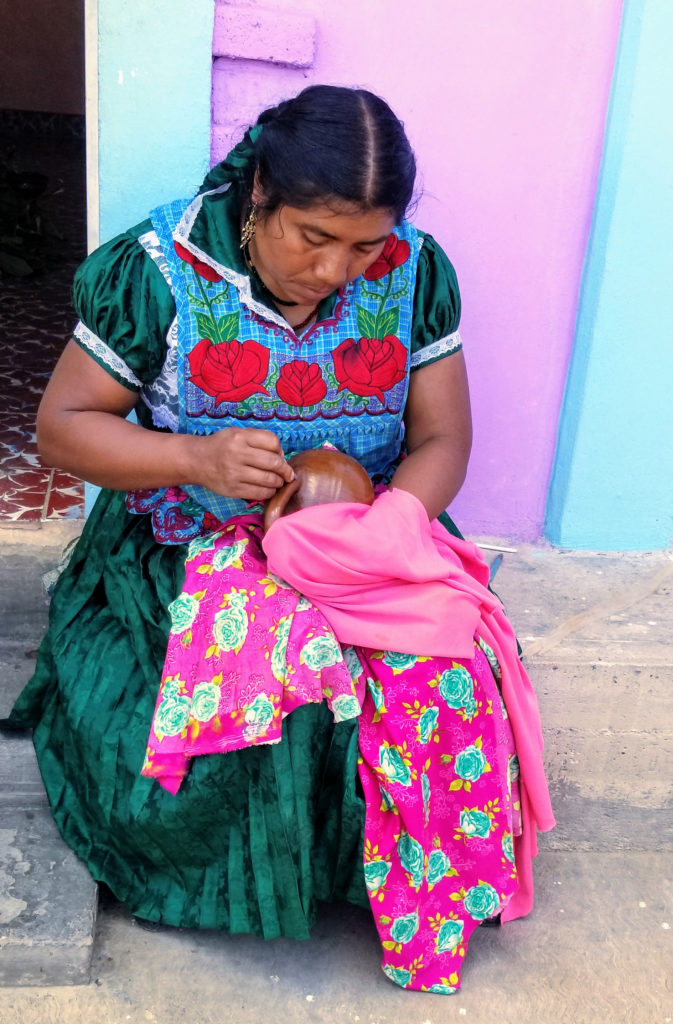
The women potters of San Marcos Tlapazola use yellow and red mud, aged three days in plastic, to mold clay by hand with the help of a leather strip. They do not use a wheel for shaping, and have an opened- air kiln for drying their pottery.

We arrived in Oaxaca the day following Dia de Los Muertos. It was our plan to see the numerous religious shrines while avoiding crowds, parades, and celebrations of the national holiday. A solitary cemetery in Tlaculula had offerings and flowers on every gravesite. We were able to pay our respects in private.
In the village of Teotitlan, Lourdes Lazo-Sosa demonstrated her technique for making mole using a stone grinder on a metate. While she ground the chiles and spices, we zipped Atole Blanco, a warn corn drink with water, cinnamon, and brown sugar. Her husband, Francisco Martinez, a renowned master weaver, works in natural colors.
Ruta Magica de las Artesanias begins in the village of San Bartalo Coyotepec or Coyote hill. The village’s distinctive black clay pottery, known as Barro Negro, comes from nearby sand-less foothills. The pottery, which cannot be use for cooking, is strictly decorative.
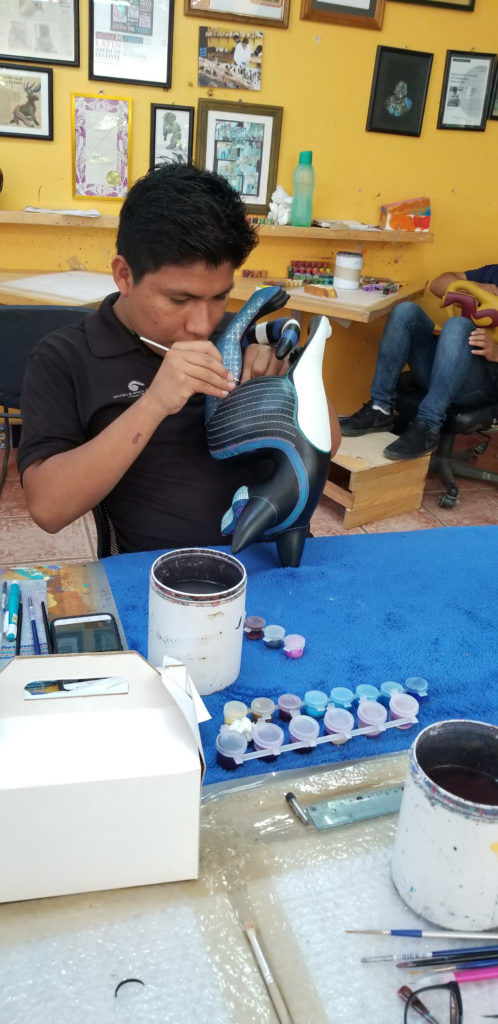
Alebrijes, wood-carved crafts are painted in a variety of colors. The combination of several animals, can be fantastic or real. The word Alebrijes translates “to scare away witches.” Internationally respected wood carvers Jacobo and Maria Angeles had their beginnings more than thirty years ago carving bulls and horses. Each carving is made from a single piece of wood. Today, the Angeles have a highly respected school, workshop, and an elite international group of collectors.
The restaurant Azucena Zapoteca, near the wood carving village of San Martin Tilcajete, is the place where we discovered tasty Tlayude, a folded crisp tortilla with meat, lettuce, cheese, a stalk of chepiche, similar to cilantro, served with guacamole and salsa. The restaurant has a charming garden strung with Mexican flags and landscaped by flowers.
Returning to Oaxaca City, we passed Montezuma Cypress Tule, which translates to swamp.
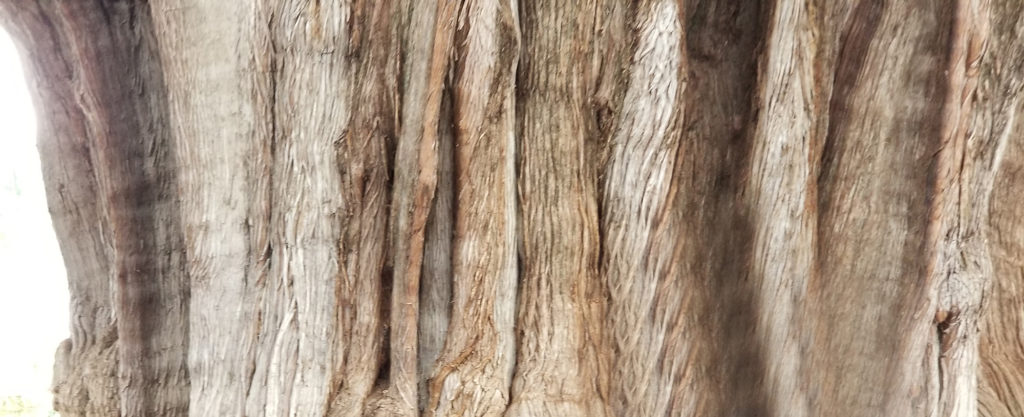
This huge tree, at least 2000 years old, attracts many visitors Monte Alban, a pre-Columbian Zapotec ruin dating back to 500 to 600-800 B.C., is the jewel of Mesoamerica archeology. Inhabited by 40,000 Zapotecs, the ruin was later ruled by the Mixtecs and Aztecs before bring conquered by Spanish Conquistadors.
The Mitla Ruins, built by the Zapotecs, is an archeological example of elaborate cut stonework. Mixtecs would conquer the Zapotecs. Unlike many Mayan ruins, Mitla was never encroached by jungle.
The agave plant Espadin is cultivate for Mezcal. Those distilled by locals are considered ancestral or artisanal. Maestro Mezcalero Pablo Arellanes Ramirez produces mezcal in the region of Santa Catarina Minas.
After roasting the hearts or pina of agave in a pit covered by river rock then fiber for four days, he uses wood barrels for fermentation. A second distillation is done in clay pots. The worm look alike in the bottom of each mezcal bottle is a moth larvae or gusano. A dozen Oaxaca producers are planning to export to the United States beginning in 2019.
Oaxaca, located in south eastern Mexico has an attraction for everyone. It might be ruins, birds, crafts, churches, museums, or just eating, one mole at a time.
